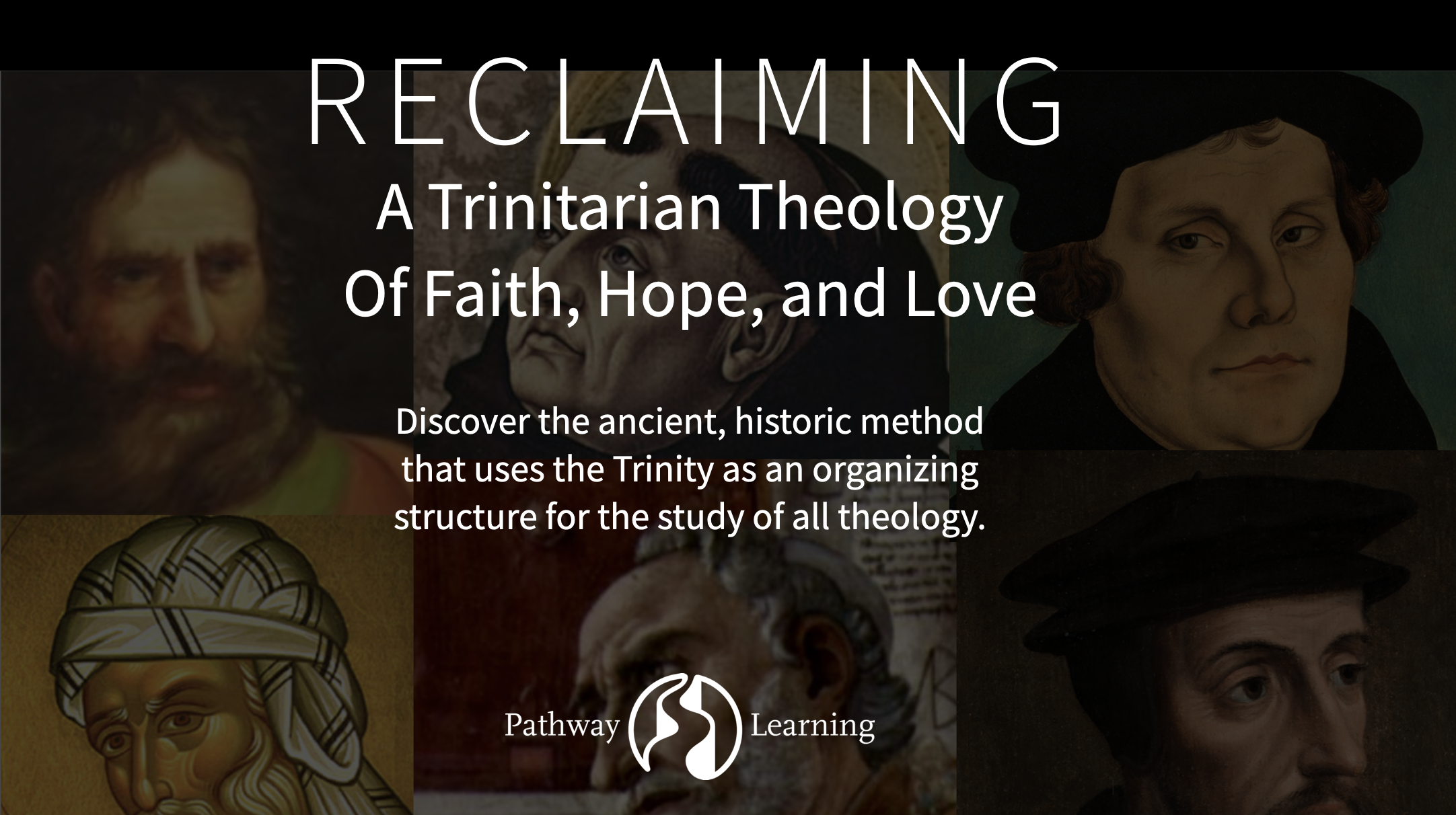Our Faith - The Apostles’ Creed: Applications in Theology, Lesson 2
Series: Applications in Theology: Faith, Hope, and Love (Lesson 2)
Authors: Drs. John M. Frame and Steven L. Childers
Title: Our Faith - The Apostles’ Creed
Everything in theology is ultimately about the revelation of the person and work of the Triune God in Scripture as Creator, Redeemer, and Restorer. So, instead of studying the doctrine of the Trinity as only one of several topics in theology, all other Christian doctrines should be studied in light of the Trinity.
The Trinitarian Faith in Scripture
This is because the Bible presents all individual, doctrinal topics as vital parts of the bigger, unfolding biblical story of who God is and what God does as Triune Lord: beginning with the Father’s creation in Genesis 1:1, reaching its apex in the Son’s redemption revealed in the New Testament, and ending with the Spirit’s restoration of all things in Revelation 22:21.
This approach to the study of theology connects us to the ancient, historic method that uses the Trinity as an organizing structure for studying all theology. The Trinitarian method of studying theology is found in all the earliest catholic (universal) creeds, including the Apostles’ Creed (120-250 AD), and the Nicene Creed (381 AD). It’s also found in the writings of the Church Fathers.
Some of the prominent theologians in history who follow this ancient, Trinitarian structure in the study of theology include Augustine (5th century), John of Damascus (8th century), Peter Lombard (12th century), Thomas Aquinas (13th century), Martin Luther (16th century), and John Calvin (16th century).
So in our study of theology, we’ll follow the Trinitarian structure rooted in the Bible and seen in the earliest Christian creeds. We’ll use the basic structure and content of the Apostles’ Creed and the Nicene Creed as our primary guides. Both creeds are essentially the same, with the Nicene Creed being longer and more comprehensive than the Apostles’ Creed. We’ll be integrating both creeds, allowing them to complement each other.
The first section of the creeds presents our historic Christian belief in “God the Father as the Lord of Creation.”
Apostles’ Creed
I believe in God, the Father almighty,
creator of heaven and earth.
Nicene Creed
We believe in one God,
the Father almighty,
maker of heaven and earth,
of all things visible and invisible.
The second section of the creeds presents our historic Christian belief in “God the Son as the Lord of Redemption.”
Apostles’ Creed
I believe in Jesus Christ, God's only Son, our Lord,
who was conceived by the Holy Spirit
born of the Virgin Mary,
suffered under Pontius Pilate,
was crucified, died, and was buried;
he descended into hell (to the dead)
On the third day he rose again;
he ascended into heaven,
he is seated at the right hand of the Father,
and he will come to judge the living and the dead.
Nicene Creed
And in one Lord Jesus Christ,
the only Son of God,
begotten from the Father before all ages,
God from God,
Light from Light,
true God from true God,
begotten, not made;
of the same essence as the Father.
Through him all things were made.
For us and for our salvation
he came down from heaven;
he became incarnate by the Holy Spirit and the virgin Mary,
and was made human.
He was crucified for us under Pontius Pilate;
he suffered and was buried.
The third day he rose again, according to the Scriptures.
He ascended to heaven
and is seated at the right hand of the Father.
He will come again with glory
to judge the living and the dead.
His kingdom will never end.
The third and final section of the creeds present our historic Christian belief in “God the Spirit as the Lord of Restoration.”
Apostles’ Creed
I believe in the Holy Spirit,
the holy catholic church,
the communion of saints,
the forgiveness of sins,
the resurrection of the body, and the life everlasting. Amen.
Nicene Creed
And we believe in the Holy Spirit,
the Lord, the giver of life.
He proceeds from the Father and the Son,
and with the Father and the Son is worshiped and glorified.
He spoke through the prophets.
We believe in one holy catholic and apostolic church.
We affirm one baptism for the forgiveness of sins.
We look forward to the resurrection of the dead,
and to life in the world to come. Amen.
The Trinitarian Faith in History
These universal creeds contain a classic summary of the Trinitarian Christian faith affirmed by most professing Christians throughout history, including those among the Orthodox, Catholic, and Protestant traditions.
Just as the Nicene Creed started with the Trinitarian structure and content of the Apostles’ Creed and then went into greater depth, so did many prominent theologians in subsequent history, including Augustine (5th century), Aquinas (13th century), and the Reformers, Martin Luther and John Calvin (16th century).
When Calvin wrote his well-known Institutes of the Christian Religion (1564), considered by many to be one of the most significant and influential Protestant Systematic Theologies, he followed this Trinitarian approach to theology in the Apostles’ Creed as seen in the titles and order of his books:
• Book One – The Knowledge of God the Creator (Father)
• Book Two – The Knowledge of God the Redeemer in Christ
• Book Three – The Way in Which We Receive the Grace of Christ (Holy Spirit)
By the Reformation, the precedent for constructing the study of theology in alignment with the Triune God’s person and work in history was well established. Following this biblical and historical precedent, we’ll study theology in this series with an intentional focus on the person and work of the Triune Lord in redemptive history.
The Trinitarian Faith in the Study of Theology Today
Under the overarching Trinitarian structure in our study of theology, we’ll include an integration of both the biblical structure (creation, fall, redemption, and restoration) and the traditional systematic structure (God, man, Christ, Salvation). And we’ll expand the systematic structure to include all the traditional topics studied in systematic theology (Bibliology, Theology Proper, Anthropology, Hamartiology, Christology, Ecclesiology, Pneumatology, Soteriology, Eschatology).
• Knowing God the Father as Lord in Creation
Bibliology: The study of the Bible
Theology proper: The study of the nature of God
• The Fall of Humanity
Anthropology: The study of humanity
Hamartiology: The study of sin
• Knowing God the Son as Lord in Redemption
Christology: The study of Jesus Christ
Ecclesiology: The study of the church
• Knowing God the Spirit as Lord in Restoration
Pneumatology: The study of the Holy Spirit
Soteriology: The study of salvation
Eschatology: The study of the end times
By using this integrated structure in Applied Theology we’re upholding the primacy of a Triune Lord-centered, gospel-centered theology that also benefits from the valuable insights of the biblical and systematic structures.
Having seen how the essence of our faith is found in the Apostles’ Creed, in our next article we’ll learn how the essence of our hope is found in the Lord’s Prayer.
Choose Your Learning Pathway


